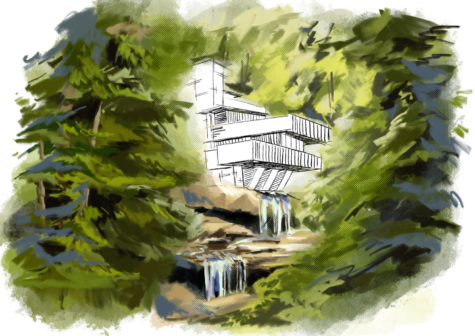Intro to U.S Housing History and Design
Architecture has always been a focal point in society both throughout history and today. While most people associate big houses or lots of land with luxury or wealth, it’s also the placing of windows and rooms, the use of materials, location, floor plans, who designed it, and more, that dictate a house’s individual worth and importance. Because the outward appearance of a structure is so heavily thought through and can hold so much information, it’s beneficial to be able to understand what the structure’s build is trying to communicate to the viewers and where it comes from. However, it is incredibly difficult- if not impossible- to summarize all the different designs and styles within one article. By starting at the basics and only covering the major, or ‘parent’ styles, the different categories should hopefully become easier to distinguish between.
Two-parent styles have been present since the origin of architecture and every single structure can easily fall into one of these categories; folk or styled. The parent styles are almost completely self-explanatory. A styled structure is a structure that is designed with the intent of looking a certain way and appealing to certain audiences. Whereas folk structures are made simply to provide shelter with little to no care or thought put into the structure’s appearance and matters only for its use. However, this article will be centered on styled homes in America.
Now, when discussing specifically American homes there are four subcategories within styled structures: Ancient classical, medieval, renaissance classical, and modern. In this case, classical is almost like a synonym for authentic or original. It is also important to mention that a lot of these styles don’t originate from the U.S. but can be seen everywhere now. For example, while Ancient Classical most definitely did not originate in the U.S., there are a lot of homes modeled after this style but with an American twist.
Ancient Classical 
Starting with the first sub-category; Ancient classical. Ancient classical was mainly popular throughout Greece in the fourth–ninth century and Rome in the first century B.C –fifth century A.D but can still be seen in various places today. This style is known for its long two-story columns in front of or around the house, which are almost always paired with a completely white or off-white exterior. The styles Early Classical Revival, Greek Revival, and Neo-Classical all share the same ornate detailing on the exterior, long skinny columns in front of or around, and a mid-pitched roof. They’re all a part of the Ancient Classical family. The only difference between those styles previously listed (Early Classical Revival, Greek revival, and Neo-Classical) is the height and placement of the columns, how prominent the entryway is, and the detailing that lines the roof. Within the U.S., this style has stayed relatively true to its roots, but one might see a house of this descent with fewer columns and as a smaller house altogether with less detailing.
MEDIEVAL 
The next sub-category of styled homes is Medieval. Medieval homes are widely known for their asymmetrical faces, Tudor-inspired designs (brown panels on the house’s exterior to the right), and the use of brick and wood. To some, medieval houses look like “witchy” houses and can also fall into the category of cottage core. As for the actual history of this design, medieval houses were popular roughly between the sixth and 15th centuries taking place after the sudden surge in ancient classical and before renaissance classical dominated the housing scene. However, the term ‘Medieval’ is an umbrella term and does little justice to all the designs that fall beneath it. So once again, this category is going to split into two groups that are slightly more specific, Medieval and Medieval with Classical detail. In short, Medieval with Classical Detail was used only for the upper class because of the extensive use of brick, personalized detailing, higher-pitched ceilings, and more windows. The other category–Medieval–was more geared to the lower/working class. The houses in that category still looked similar, but with simpler designs and structures on a smaller scale. However, everything within the Medieval group does look like some variation of the house pictured above.
RENAISSANCE CLASSICAL
Within this category, it gets a little bit trickier to follow at times. Right away there’s a triple split from Renaissance Classical into three new sub-sections but this time the split is based on the place of origin for the styles. The three new styles are Italian, English, and French. As for a timeline, this style entered Italy and gained popularity around the 15th– 16th century, then it moved to England during the 17th century, and finally to America in the 18th century. All three of these places have signature specialty designs that they’re known for which can help differentiate one style from another. Italian Renaissance Classical houses embellish arches, English-styled houses prioritize accentuated doors, and French-styled homes are known for their unconventionally shaped roofs (high pitched/curved). One consistent aspect between the three styles (as can be seen below in the second row of pictures) is symmetry and decorative detail- such as crowned/outlined doors or windows, dentils, quoins, and/or pilasters.



Italian (arches): 
English (door):
French (roof): 

MODERN
Granted, all of the categories mentioned previously are fairly big umbrella terms, yet the sub-category ‘Modern’ might have to be the broadest of them all. Modern is just like the music genre Pop, it doesn’t have any specific guideline or requirement or well-known distinguishing factor, it just depends on the era, people, and location that one is discussing. For example, in U.S. 2020-2022, Modern generally looks like two-story boxy houses with lots of concrete, steel, and glass or houses that take inspiration from industrial-styled structures with muted colors. Whereas modern in the 1970s could have looked more like a rambler with lots of color on the interior and interior and exterior wood paneling.
Some of the types of houses that fall under the label modern include arts and crafts, prairie, craftsman, art nouveau, and more (pictures included of the styles listed below). The beauty of designing modern architecture is that there’s no bar that one must reach or specific aspects that need to be present in order for the structure to make an impact, which is why modern has been a present category for so long. This category serves as a kind of catch-all for the architecture styles that don’t fit anywhere else, but also provides artists with the space to design whatever they want without the historical pressure and expectation of previous builds.
Today’s modern: 
1970s Modern: 
Craftsman:
Prairie:
Art Nouveau: 
Arts and Crafts: 
Sources
- Dates and information are referenced from the book “A field guide to American houses” Written by Virginia and Lee McAlester
- Personal review: I highly recommend this book if you’re looking to read about architecture or design. It’s very easy for beginners to understand and contains lots of well-written information with drawings and photos of everything.
- Ancient Classical
- Medieval:
- Renaissance Classical:
- Italian:
- Quoin: https://www.thoughtco.com/what-is-a-quoin-177497 – :~:text=Quoin, which means “corner”,Western architecture, particularly Georgian styles.
- Pilaster: https://www.thoughtco.com/what-is-a-pilaster-engaged-column-4045117 – :~:text=A pilaster is a rectangular,a capital like a column.
- English:
- French:
- Today’s Modern
- 1970s Modern
- Prairie
- Arts and Crafts
- Art Nouveau
Your donation will support the student journalists of Mounds Park Academy. Your contribution will allow us to purchase equipment and cover our annual website hosting costs.










